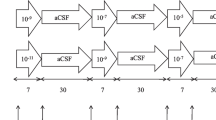Abstract
Anaesthetized rats, endotracheally intubated and mechanically ventilated with room air, were subjected to a 5-min period of asphyxia by turning off the ventilator. The ventilator was then turned back on and, simultaneously, the animals were treated with either the adrenocorticotropin fragment 1–24 [ACTH-(1–24), 160 µg/kg in a volume of 1 ml/kg i.v.] or an equivalent volume of saline. Nitric oxide (NO)-haemoglobin formation was detected ex vivo in arterial blood by electron spin resonance spectrometry; arterial blood pressure, electrocardiogram (ECG) and electroencephalogram (EEG) were monitored for a 60-min observation period, or until prior death. During asphyxia, there was massive formation of NO (red cell concentrations 40–80 µM), associated with a dramatic fall in mean arterial pressure and pulse pressure, marked bradycardia and ECG signs of ischaemic damage, as well as an isoelectric EEG. Treatment with ACTH-(1–24) produced a prompt (within 15 min) and long-lasting drop in NO blood levels, associated with an almost immediate (within 1 min) restoration of cardiovascular function and with a more gradual recovery of EEG, which became normal after 30–40 min; all parameters remained stable throughout the 60-min observation period. In saline-treated rats, on the other hand, there was a further increase in NO blood levels, as detected 3 min after treatment, and all died within 5–8 min. Moreover, pretreatment and treatment with S-methylisothiourea sulphate (SMT, 3 mg/kg i.v.), a relatively specific inhibitor of inducible NO synthase, inhibited NO formation, but did not affect the mortality rate (100% within 5–8 min). The present results provide the first evidence that prolonged asphyxia is associated with high blood concentrations of NO, and that the life-saving effect of melanocortin peptides in severe hypoxic conditions is associated with a complete normalization of NO blood levels. However, the lack of SMT protection in this experimental model seems to rule out the possibility that the ACTH-(1–24)-induced resuscitation is due to an effect on NO overproduction.
Similar content being viewed by others
Author information
Authors and Affiliations
Additional information
Received: 29 June 1998 / Accepted:13 October 1998
Rights and permissions
About this article
Cite this article
Bazzani, C., Bini, A., Cainazzo, MM. et al. High blood levels of nitric oxide in rats subjected to prolonged respiratory arrest and their modulation during adrenocorticotropin-induced resuscitation. Naunyn-Schmiedeberg's Arch Pharmacol 359, 53–59 (1999). https://doi.org/10.1007/PL00005323
Issue Date:
DOI: https://doi.org/10.1007/PL00005323




